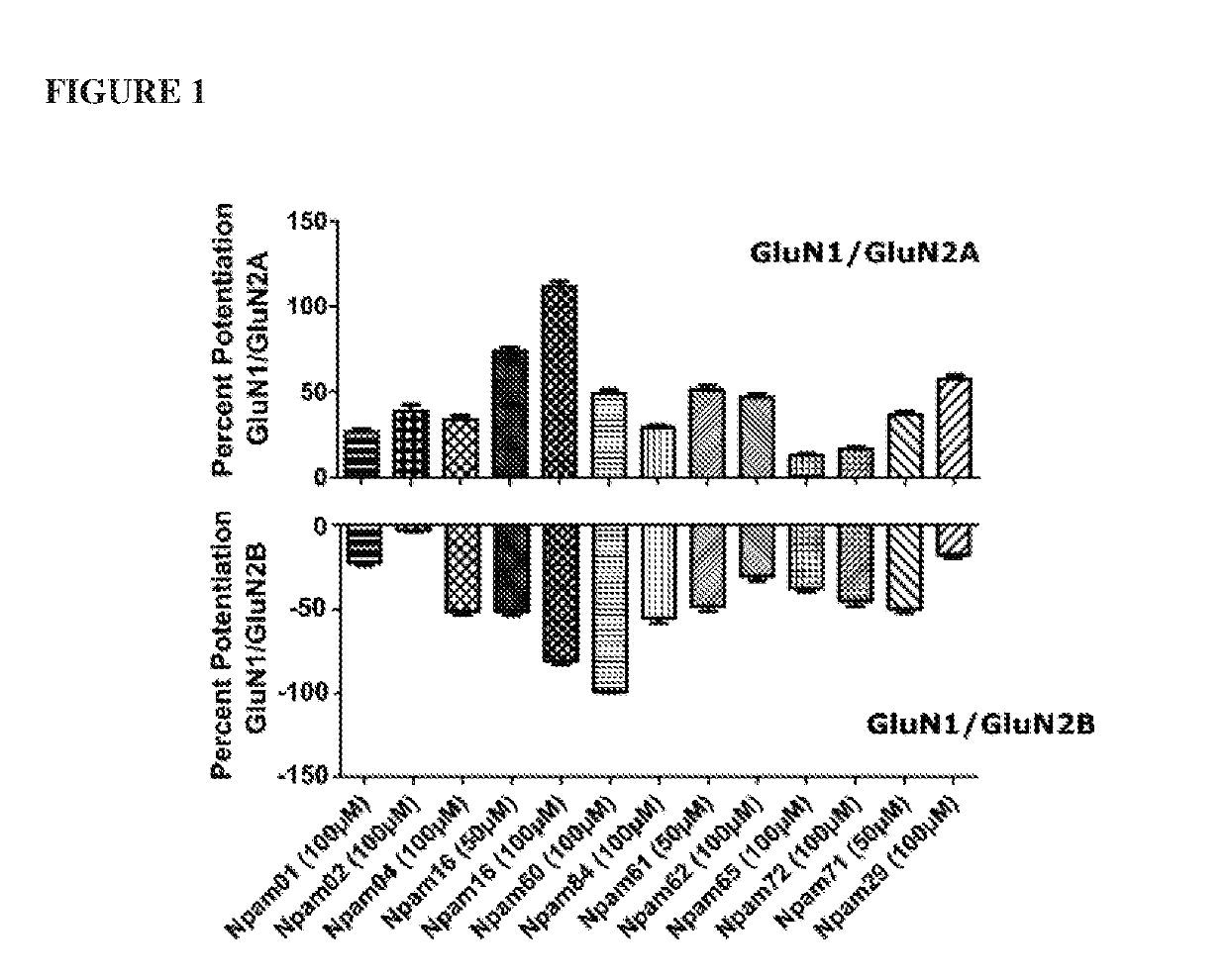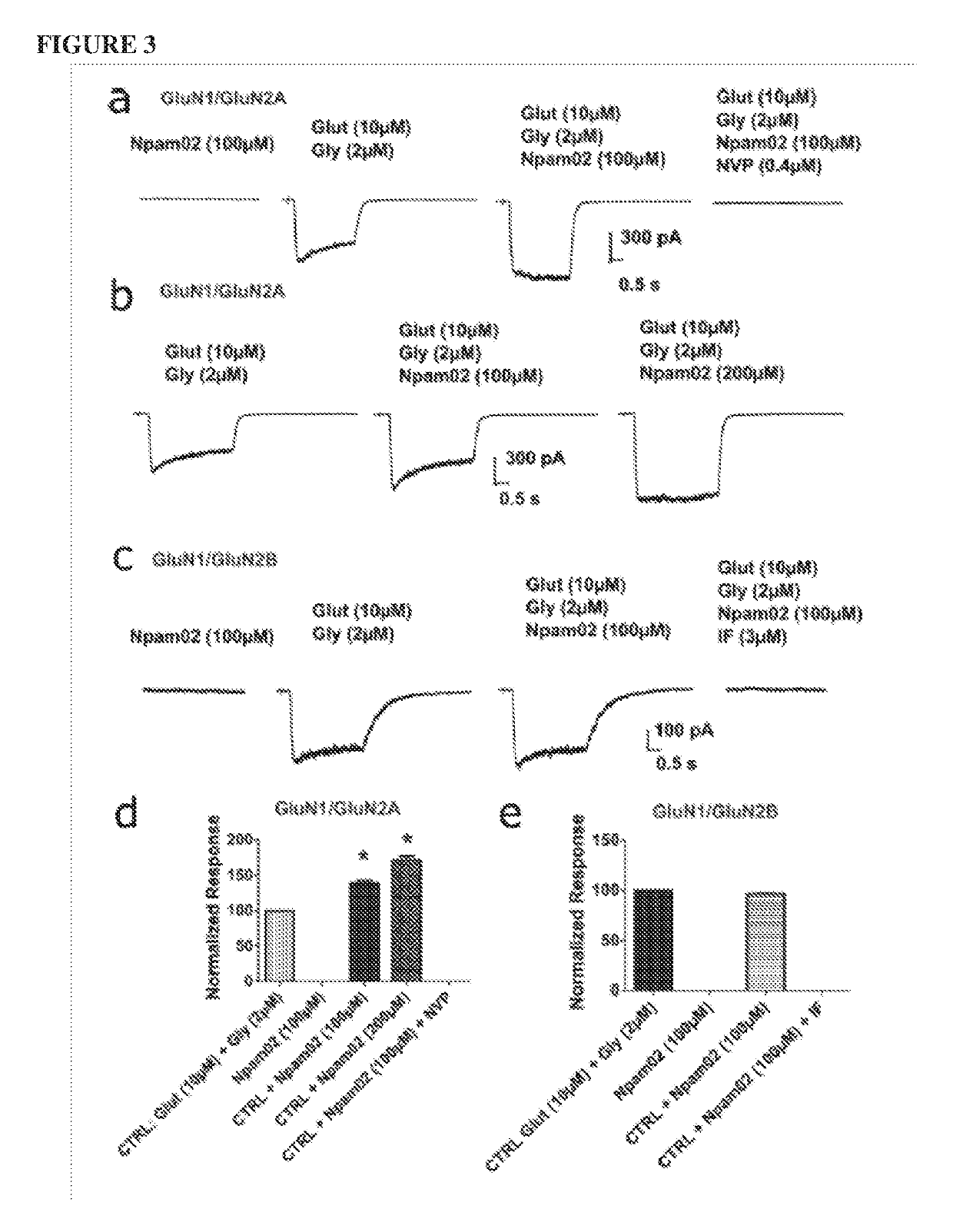N-methyl-d-aspartate receptor allosteric modulators and methods for their use
a technology of n-methyl-d-aspartate receptor and allosteric modulator, which is applied in the field of therapeutic compounds, can solve the problems of slow cell death, brain damage, and rapid loss of brain function
- Summary
- Abstract
- Description
- Claims
- Application Information
AI Technical Summary
Benefits of technology
Problems solved by technology
Method used
Image
Examples
example 1
Identification of Positive Allosteric Modulators
[0227]GluN1 / GluN2A NMDAR subtypes are an attractive target for positive allosteric modulation. The present inventors employed in silico computational drug discovery methods to conduct a virtual screen of purchasable lead-like compounds from the ZINC database (Irwin, J., et al. Abstr Pap Am Chem Soc (2005) 230:U1009) and some synthetic compounds to identify potential GluN1 / GluN2A-NMDAR modulators. The in silico methods included large-scale docking against the interstice interface of the GluN1 / GluN2A heterodimer and consensus scoring to select compounds for empirical testing. Candidate compounds were further screened by using GluN1 / GluN2A transiently transfected in human embryonic kidney (HEK293) cells and tested by whole-cell patch clamp recordings.
[0228]Table 1 shows synthetic and ZINC database compounds that were identified as having a positive modulation effect on GluN1 / GluN2A NMDARs.
TABLE 1Potentiation effects of synthetic (syn) com...
example 2
Identification of Modulators Selectively Potentiate GluN1 / GluN2A-Containing NMDARs
[0229]The inventors used transiently transfected HEK293 cells expressing either GluN1 / GluN2A or GluN1 / GluN2B NMDARs and tested by whole-cell voltage patch clamp recordings to see whether selected compounds were controlling the subtype selectivity profile of the drugs.
[0230]Table 2 shows some identified compounds that showed a positive modulation of the GluN1 / GluN2A NMDARs and / or inhibition effect of GluN1 / GluN2B NMDARs. FIG. 1 shows various modulatory effects of several Npam compounds on NMDAR-mediated currents using data from whole-cell patch electrophysiological recordings. FIG. 1 demonstrates that Npam compounds may have a positive potentiation effect on recombinant GluN1 / GluN2A NMDARs and / or an inhibitory effect on GluN1 / GluN2B NMDARs, and / or little to no effect on GluN1 / GluN2B NMDARs.
TABLE 2Hit compounds identified in the first screenshowing positive modulation of GluN1 / GluN2A NMDARsand / or inhibit...
example 3
Characterization of Npam02
[0233]3.1 Evaluation of the Potentiation Effect of Npam02 in HEK293 Cells Transfected with GluN1 / GluN2A or GluN1 / GluN2B.
[0234]Whole-cell patch clamp recordings were performed to measure glutamate evoked currents with chloride-based pipette solutions at a holding potential of −60 mV.
[0235]To rule out the possibility that Npam02 itself may induce any currents in the GluN1 / GluN2A or GluN1 / GluN2B expressing HEK293 cells, Npam02 (100 μM) was applied alone and no changes of inward or outward currents (FIG. 3a, d). Co-application of Npam02 (100 μM) with co-agonists modestly enhanced NMDA-mediated currents in HEK293 cells expressing GluN1 / GluN2A receptors (100 μM; n=6; 38.85±3.70%; P<0.001; and (200 μM; n=6; 71.69±5.03%; P<0.001) (FIG. 3b, d) compared to glutamate application alone (FIG. 3a, d). The increased NMDAR currents could be completely blocked by the co-application of a selective GluN1 / GluN2A antagonist of NVP-AAM007 (0.2 μM) in the presence of both co-agon...
PUM
 Login to View More
Login to View More Abstract
Description
Claims
Application Information
 Login to View More
Login to View More - R&D
- Intellectual Property
- Life Sciences
- Materials
- Tech Scout
- Unparalleled Data Quality
- Higher Quality Content
- 60% Fewer Hallucinations
Browse by: Latest US Patents, China's latest patents, Technical Efficacy Thesaurus, Application Domain, Technology Topic, Popular Technical Reports.
© 2025 PatSnap. All rights reserved.Legal|Privacy policy|Modern Slavery Act Transparency Statement|Sitemap|About US| Contact US: help@patsnap.com



